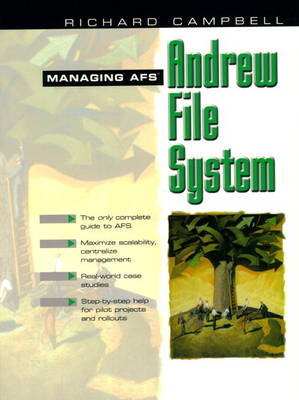
Managing AFS
Prentice Hall (Verlag)
978-0-13-802729-2 (ISBN)
- Titel ist leider vergriffen;
keine Neuauflage - Artikel merken
This book describes, in detail, the benefits of using the AFS distributed file system in large and small organizations. By relieving administrators of inefficiencies of scale and allowing users to retrive files effectively from anywhere in their organization. This book demonstrates the power of using an integrated, fully functional, and centrally managed system to provide a ubiquitous and reliable data storage system. This book explains how to manage AFS to its greatest effect incuding the installation of an adequate server setup to handle thousand of clients with a minimum of administrator and hardware overhead.
RICHARD CAMPBELL has worked for the last five years as a distributed computing consultant on Wall Street. Previously, he was a senior researcher at the Institutional File System Project at the University of Michigan, which established AFS as the distributed file system for the campus of over 30,000 users.
Each chapter concludes with a Summary.
1. Architectural Overview.
Beginnings. Benefits of AFS. Global Filesystems. Drawbacks. Other Sources of Information.
2. AFS Technology.
Client Configuration. Reading Data. Writing Data. Server Configuration. Volume Management. Server Processes. Network Protocol. AFS Extras.
3. Setting Up an AFS Cell
Preliminary Decisions. Hardware Requirements. Installation Overview. The Basic Overseer. File Services. Database Services. Server Machine Types. Adding More Machines. Ubik. Time Synchronization.
4. AFS Volumes and Files.
Volume Operations. An Example Volume. Backup Volumes. Moving Volumes. The Volume Location Database. Replication. Client Path Preferences. Conventional Namespaces. Deleting Volumes. Querying the Databases. Suggested Practices.
5. Client Administration.
Configuration. Cache Manager. Finding AFS Servers. Protocol Optimizations. Windows NT Clients. PC-Enterprise. Installing Clients and AFS Paths. Convenient Path Names. Set-User-Identifier Programs. Time Services. Messages.
6. Managing Users.
Kerberos. AFS's Kerberos. User Databases. Setting Up a User Account. Kerberos and Passwords. Ticket Lifetimes. The uss Utility.
7. Using AFS.
Authentication. Protection Data. Access Control Lists. Negative Rights. Groups and ACLs. More Group Management. Machine Groups. Volumes Revisited. Backup Volumes. Checking for Errors. AFS versus UNIX. Programming Issues. System Software. Using AFS on Windows NT.
8. Archiving Data.
The Archive System. Volume Sets. Dump Levels. The Tape Coordinator. Tape Labels. Running the Dumps. Querying the Databases. Getting the Data Back. Automating Dumps. Saving the Backup Database. Common Strategies. Volume Dumps. AFS Database Archiving. Third-Party Software. Legato's Networker. IBM's ADSM. PDC's BudTool
9. More AFS Administration.
Administrative Credentials. Server Management. Updating AFS Binaries. Job Notification. KeyFile Management. Changing the Cell Name. Database Servers. File Servers. Salvager Data. Networking Support. NFS-AFS Gateways. Administration Examples. E-Mail, NetNews, and the Web. Third-Party Software. Other Administration Tools.
10. Debugging Problems.
File Server Performance. File Server Problems. Salvaging Files. Database Servers. Ubik Debugging. The scout Monitor. Afsmonitor. AIX Auditing. Client Debugging. Cache Problems. Disaster Recovery. Crashing. Version Control. Security Issues.
11. Large-Scale Management.
Case Study: IBM. Case Study: Morgan Stanley. Case Study: University of Michigan. Case Study: Multiresident AFS.
12. Implementing AFS.
The Business Case. An AFS Project. Operational Buy-In. Ongoing Work. AFS Futures. DCE and DFS. The Competition.
12. Appendix A: AFS Command Suite
Bibliography.
Index.
| Erscheint lt. Verlag | 4.3.1998 |
|---|---|
| Verlagsort | Upper Saddle River |
| Sprache | englisch |
| Maße | 236 x 178 mm |
| Gewicht | 798 g |
| Themenwelt | Mathematik / Informatik ► Informatik ► Betriebssysteme / Server |
| Informatik ► Office Programme ► Outlook | |
| Informatik ► Weitere Themen ► Hardware | |
| ISBN-10 | 0-13-802729-3 / 0138027293 |
| ISBN-13 | 978-0-13-802729-2 / 9780138027292 |
| Zustand | Neuware |
| Haben Sie eine Frage zum Produkt? |
aus dem Bereich


